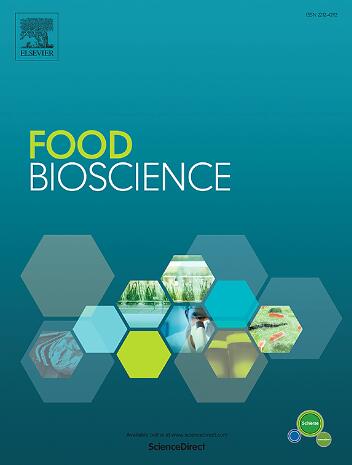探索蟋蟀养殖的侧流循环利用:昆虫生物学和化学成分
IF 4.8
1区 农林科学
Q1 FOOD SCIENCE & TECHNOLOGY
引用次数: 0
摘要
本研究旨在提高农场蟋蟀(Gryllus assimilis)的生产性能,了解其蛋白质和脂肪酸含量积累,并对不同饲料进行配方和评价。粮农组织推荐的以玉米-豆粕-玉米油为基础的对照饲料与新鲜羽衣甘蓝补充剂和不含玉米油的低脂饲料进行了比较。此外,还研究了另外3种含侧流小麦胚芽、酿酒废粮和花生的饲料。饲料对蟋蟀的生物学参数有一定的影响,羽衣甘蓝、小麦胚芽和BSG饲料可提高蟋蟀的早期成活率和成虫体重。昆虫的体重为0.5至0.75克。饲料中足够的脂肪含量(4%)对蟋蟀的短发育期、产卵和卵的存活率至关重要。与对照组、羽衣甘蓝和低脂饲料相比,饲喂小麦胚芽、牛肉精和花生饲料的蟋蟀总蛋白质含量较低,这是由于侧流饲料中蛋白质含量较低。脂肪酸分析显示C18:2的丰度最高,其次是C18:1、C16:0和C18:0。BSG产生了高丰度的总多不饱和脂肪酸(PUFA),主要是C18:2 (n = 6)。利用啤酒废物进行饲料开发可以提高蟋蟀蛋白质生产的可持续性,用于食品和饲料用途。本文章由计算机程序翻译,如有差异,请以英文原文为准。
Exploring side streams upcycling for crickets farming: Insects biology and chemical composition
This study formulated and evaluated different feeds for farm crickets (Gryllus assimilis) aiming to enhance productive performance, and understand protein, and fatty acid content accumulation. A control feed based on corn-soybean meal-corn oil, recommended by FAO, was compared with a fresh kale supplement, and low-fat variant lacking corn oil. Additionally, three other feeds incorporating the side streams wheat germ, brewing spent grains (BSG), and peanuts were also investigated. The biological parameters of the crickets were influenced by the feeds, with improved early-stage survival rate and adult weight observed with kale, wheat germ, and BSG feeds. The body weight of the insects ranged from 0.5 to 0.75 g. An adequate fat content (>4 %) in feeds is crucial for crickets short development period, oviposition, and egg viability. The total protein content of crickets fed with wheat germ, BSG, and peanut feeds was lower compared to the control, kale, and low-fat feeds, due to lower protein content in side stream feeds. Fatty acid analysis revealed a predominant abundance of C18:2, followed by C18:1, C16:0, and C18:0. BSG resulted in a high abundance of total polyunsaturated fatty acid (PUFA), mainly C18:2 (n = 6). Utilizing brewery waste for feed development enhances the sustainability of cricket protein production for food and feed uses.
求助全文
通过发布文献求助,成功后即可免费获取论文全文。
去求助
来源期刊

Food Bioscience
Biochemistry, Genetics and Molecular Biology-Biochemistry
CiteScore
6.40
自引率
5.80%
发文量
671
审稿时长
27 days
期刊介绍:
Food Bioscience is a peer-reviewed journal that aims to provide a forum for recent developments in the field of bio-related food research. The journal focuses on both fundamental and applied research worldwide, with special attention to ethnic and cultural aspects of food bioresearch.
 求助内容:
求助内容: 应助结果提醒方式:
应助结果提醒方式:


